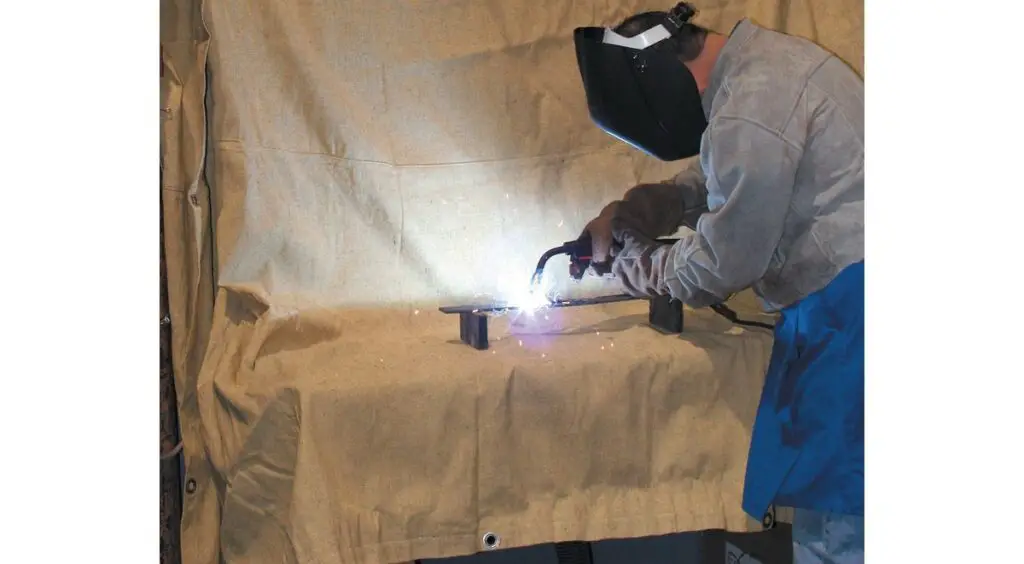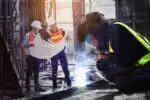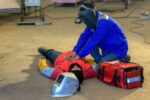Welding is a risky profession, hence safety measures such as PPEs and welding blankets are required to protect both the welder and the equipment.
So what exactly is a welding blanket?
Welding blankets are heat-resistant fabrics that can act as a shield, protecting other materials from sparks and spatter. It is critical to safeguard yourself and your surroundings during welding.
Welding blankets come in a variety of materials, sizes, and purposes. It might be difficult to determine the sort of welding blanket you require, however, hold on to this article to know more about different materials of welding blanket and its features.
Why do you need a welding blanket?
You need a welding blanket because a molten spatter or a spark of flame might destroy nearby furnishings and inflict serious bodily harm to you while working. Therefore, a good welding blanket may protect you from serious burns and keep you safe.
What should you look for in your welding blanket?
1. Safety features
Safety features such as flame retardant properties are something you should look out for in your welding blanket. You should inspect the materials utilized and ensure that they are truly resistant to heat and flame so that your safety isn’t compromised.
Many brands claim to offer heat resistance and flame retardancy, however, not all of them follow through on their commitments. There are certain welding blankets that are not heat resistant and may develop char marks or even burn holes.
Fiberglass is a good example of material. Fiberglass has isolating properties and helps to keep higher temperatures at bay. Carbon fibers, on the other hand, are just as effective.
2. Durability
It’s not a good idea to settle for when it comes to your welding blanket, and that is why durability is so important. Make sure the welding blanket is long-lasting enough that you won’t have to replace it after two or three uses.
Inquire about the material used in a welding blanket to obtain a sense of its quality, and you should examine the greatest temperature your material can withstand.
3. Thickness
The level of thickness corresponds to the level of protection desired. It is also affected by the welding process. The thicker a welding blanket, the more dependable it is.
As a result, you should select a higher amount of thickness so that you may reuse it. If you choose a bigger welding blanket, you may get the appropriate thickness by folding it numerous times.
4. Have a look at its material composition
It is critical to guarantee that the material does not include any hazardous chemical components, such as asbestos (which causes various illnesses if inhaled frequently).
You should also check to see if the material contains other ingredients like polyurethane, vermiculite, silicate, clay, or graphite which is not at all good for your health.
5. The proper size
The size of a welding blanket can have an impact on the outcome of a welding process. As a result, there is no hard and fast rule for selecting the proper size.
It all depends on how comfortable you are with a certain size of welding blanket.
However, for industrial operations, you’ll need a large-sized welding blanket as they are great for covering the whole area while still allowing for safety and protection.
6. Comfort
The comfort of your welding blanket is also one important factor. Fiberglass, for example, has a rougher feel because it hardens quickly. Although it might be soft enough to be used as a fabric, it can yet have a gritty feel to it.
If you have sensitive skin, you may always choose a softer material. Rolling stiff fabrics might be problematic as well.
7. Pricing
Although welding blankets vary in price, you should choose the one that appears to offer the most value for money. Again, materials are important in this case.
Aside from understanding the material, it is always recommended to check reviews of customer feedback regarding a certain welding blanket.
Even if a welding blanket appears to be expensive but has favorable ratings, there is a good probability that its performance will not disappoint you.
See also: Can a Welding Blanket Be Washed?
Different materials for welding blankets
1. Leather
Leather is extremely gentle on your skin. It is, however, costly, heavy, and deforms when exposed to welding heat for an extended period of time. It is also vulnerable to oil, acids, and other contaminants.
However, because of its inherently fire-resistant nature, it is used to make several welding garments such as jackets, sleeves, gloves and aprons.
2. Fiberglass
Fiberglass is the most often used material for producing long-lasting and sturdy welding blankets. It is constructed out of components that are comparable to those used in the production of glass.
The components are combined, heated, and threads are spun from them. The fiberglass strands are woven to create the fiberglass blanket.
Because fiberglass has a high melting temperature, it is ideal for manufacturing welding blankets. Unfortunately, fiberglass sheds microscopic amounts of material that can irritate the skin.
A coating is generally applied to avoid this and increase other qualities like heat resistance in the material.
3. Felt
Felt is a substance created from carbonized fibers that have been pressed. It is resistant to high temperatures of up to 1800°F, is skin-friendly, and is inexpensive.
If necessary, it may also be trimmed, and it has strong insulating capabilities. However, felt is not a long-lasting material. This is because it is a textile formed by pressing threads together rather than weaving them.
Carbon felt has a temperature resistance of around 1800°F, which is significantly greater than leather and fiberglass.
Felt is also suitable for people with sensitive skin as it is very soft, which means it won’t bother your skin.
4. Ceramic
Ceramic is a tough substance that is ideal for tough industrial welding blankets. It provides the best protection against strong splatter and severe heat. However, it is costly and hazardous, and it must be handled with caution.
Here is a table to help you make a detailed choice-
| Durability | Heat resistance | Skin- friendly | Cost | |
| Leather | High | Medium | Medium | High |
| Fiberglass | High | Medium | Low | Medium |
| Felt | Low | High | High | Low |
| Ceramic | High | Medium | Low | High |
Now let us see the different categories of welding blankets depending on the level of heat resistance they provide.
1. Heavy duty welding blankets- Heavy duty blankets are made of silica textiles with long-lasting coatings like vermiculite, and these blankets provide longer-lasting protection and heat resistance up to 1800°F.
These blankets can survive heavy spatter for an extended period of time and are strong enough to be used flat and weld immediately over them with caution.
2. Medium duty welding blanket- Medium duty blankets are made of thicker, denser fiberglass with superior coatings like graphite.
These blankets provide increased heat-shielding up to 1000°F or more and can withstand typical welding spatter. For frequent use, these blankets are the most cost-effective.
While medium-duty blankets feature coatings that increase resistance to splatter and burn through, they cannot be used in the flat position, unlike heavy-duty welding blankets.
3. Light duty welding blankets- Light duty blankets are made of heat-treated fiberglass or with silicon coatings.
For a limited duration, these blankets provide thermal protection ranging from 500°F to 1000°F. Light-duty blankets are thin and can withstand light cutting, welding sparks, and weld splatter.
Light-duty blankets, on the other hand, are not strong enough to be laid flat and welded over. If you do, you risk solidifying welding spatter or possibly burning through the blanket.
4. Industrial welding blanket- The most durable and reliable welding blankets are made of ceramic materials with a vermiculite layer. These blankets provide continuous protection at temperatures as high as 2200°F and as low as 3000°F.
Conclusion
When welding, it is critical to protect both oneself and the surrounding region. Molten spatter or sparks can cause property damage or even injury to anyone in the vicinity of the welding area.
Fortunately, a decent welding blanket can assist you in this situation. You can easily make a sensible purchasing decision now that you know how to purchase the proper welding blanket.







